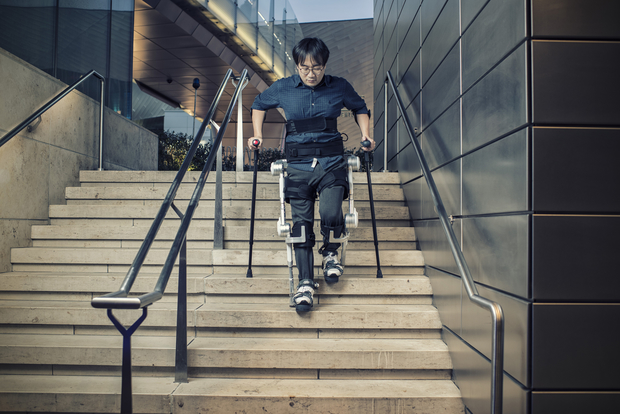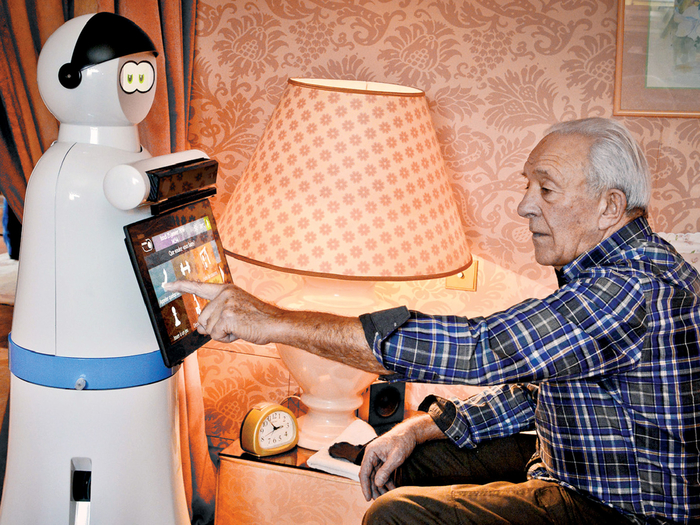
Robohub.org
Robots pick up the challenge of home care needs

The Hyundai Medical Exoskeleton (H-MEX), composed of a high-tech back/leg brace combination device and forearm crutches, is meant to help paraplegics walk again (Photo: Hyundai)
This article was first published on the IEC e-tech website.
Advances in sensors have increased the ability of assistive robots to perform domestic handling and mobility assistance tasks as well as to analyze the environment and individuals around them so that they can carry out monitoring functions. About 4 700 elderly assistance robots were sold globally in 2015, according to the International Federation of Robotics in Frankfurt, which forecasts that sales will increase to 37 500 units between 2016 and 2019.
Robots assisting with healthcare delivery in the home not only increase their users’ autonomy but also have the potential to relieve the burgeoning demands that elderly populations place on health and care services and informal caregivers.
Meanwhile, increasingly sophisticated “companion robots” are being developed to interact with users, make social connections with them and even provide companionship and emotional support, subject to personal choice.
Several IEC Technical Committees (TCs) and Subcommittees (SCs) cooperate on the development of International Standards for the broad range of electrotechnical systems, equipment and applications used in care robots, with an emphasis on safety and interoperability.
Care robots and other assistive robotic devices form part of the wider category of Active Assisted Living (AAL) technologies. All are designed to enhance the quality of life of users and enable them to lead independent lives through the use of Information and Communication Technology (ICT).
The IEC Systems Committee on AAL (SyC AAL), which started work in 2015, has the role of promoting safety, security, privacy and cross-vendor interoperability in the use of AAL systems and services, and of fostering standardization that enables their usability and accessibility.
Human-robot interaction
Assistive robots with sensory and monitoring functions have been in use in healthcare for over a decade.

Paro, modelled on a baby seal, is a companion robot that responds to touch and can make eye contact (photo: UCI UC Irvine)
In 2004, Japanese inventor Dr Takanori Shibata created a 3 kg robot called Paro. The robot is modelled on a baby seal and makes a similar plaintive crying sound. Paro, one of the most widely studied care robots, responds to touch and can make eye contact by detecting the direction from which voices come. It also has a degree of artificial intelligence, including the ability to “learn” behaviour that elicits a positive and empathetic response in the “user” (for instance, being stroked) rather than one that evokes anger, and then to repeat the behaviour that causes the positive response. Some 5 000 Paro robots have been used in more than 30 countries, in therapeutic settings ranging from dementia care to helping earthquake survivors.
Tasks include helping carers as well as patients
Today’s assistive robots can navigate autonomously and carry out a wide range of tasks such as handling, providing assistance with mobility, lifting and bathing in order to reduce the workload of care providers. Their capabilities may include human-robot interaction skills such as face recognition, speech and gestures. These robots are equipped with multiple digital cameras for reading facial expressions and recording the near environment, and stereo microphones and speakers for monitoring and communicating with users. Some models have databases containing photo galleries, music and brain exercises for the elderly.
IEC TC 62: Electrical equipment in medical practice, and its SCs develop International Standards for the electrical equipment and systems and the software used in healthcare. Their work focuses on safety and performance, including data security and confidentiality. There is a joint working group concerned specifically with the safety of the surgical robots and assistive robots used in healthcare.
IEC TC 100: Audio, video and multimedia systems and equipment, has set up a Technical Area, TA 16: Active Assisted Living (AAL), accessibility and user interfaces, to address AAL‑specific issues related to audio, video and multimedia systems and equipment (see article Improving access to multimedia content for those with disabilities in October 2016 e-tech).
Sensors used in care robots include heart rate and blood pressure monitors; sensors to detect changes in motion, audio and scent which could indicate potentially dangerous scenarios for people living alone; range sensors for fall detection; force/torque sensors; light detection and ranging (Lidar) navigation sensors; and red, green and blue image plus depth (RGB-D) sensors for additional navigation data, enabling the robot to perceive objects and people with which it can interact. IEC SC 47E: Discrete semiconductor devices, prepares International Standards for the design, manufacture and use of sensors.
Other IEC TCs involved in standardization work for assistive robots include IEC TC 110: Electronic display devices, and IEC TC 21: Secondary cells and batteries.
As well as care robots, motorized wheelchair robots and exoskeletons offer autonomous motion assistance for the elderly and disabled. Some “robot walkers” are equipped with GPS and wireless Internet connectivity to summon help in an emergency – for instance, a fall – and to enable users’ families to monitor them remotely.
Companion robots
Companion robots are emerging as a specific category. They are designed to act as interfaces that will make it easier for the elderly to enrich their social lives and connect with their families and friends. Typically, they are powered by small electric motors and equipped with high‑definition cameras, voice and facial recognition capabilities, wireless internet connectivity, video‑calling apps, music libraries, memory games and colour-changing LEDs to indicate a device’s “mood”.
An “advanced social companion robot” undergoing trials in California this year is designed to “convey emotion” through different speech tones, sounds, lights and body language. As well as reminding users to take their medication, this robot proactively suggests activities such as reading, going for a walk, playing games or phoning friends. The device uses machine learning to tailor these suggestions to individual preferences.
The European Union and the Japanese government are jointly funding an international research project that will run from 2017 to 2020 to develop “culturally aware robots” to assist with elderly care. Dr Chris Papadopoulos of the University of Bedfordshire in the UK says that elderly users are more likely to accept robots which can “autonomously reconfigure their interactions to match the culture, customs and etiquette of the person they’re caring for”.
Designers of companion robots face issues related to privacy and care‑giving ethics, as well as many technical challenges, not least that robots are currently unable to detect the subtleties of human interactions and therefore to assess people’s moods and feelings.
Analysts see rapid adoption
Healthcare accounts for a substantial sector of the robotics market, primarily in the form of surgical robots. However, the availability of assistive robots for elderly care offering greater functionality and at cheaper prices will see this nascent market segment grow too, particularly in Japan, South Korea, Western Europe and North America.
The consultancy firm Frost & Sullivan predicted in December 2016 that the global market for care assistance and automation robots is expected to achieve rapid adoption, with a Compound Annual Growth Rate (CAGR) of 36% until 2021.
According to Japanese government data, the country’s “care‑bot” market is expected to increase 25‑fold to USD 3,7 billion by 2035.
In the EU, the market for robots and devices assisting elderly people is estimated to reach EUR 13 billion by 2016, according to the Robohub website.
The high cost of assistive robots (currently thousands of dollars each) and the challenges of building safe and certified robotic devices are among the factors restraining market growth.
Access all areas
Japan, a world leader in “eldercare robotics”, has pioneered the development of robots to lift and carry elderly patients and so alleviate the physical strain on care workers.

In addition to talking, understanding speech and navigating autonomously, the Kompaï care robot can keep track of shopping lists, plays music, and work as a videoconference system for users to talk with their doctors, for example (Photo: Robosoft)
At a February 2017 “hackathon” in Singapore on the social use of robotics for elderly healthcare, the winning team proposed an autonomous system using the Segway Robotics platform, Loomo, for transporting wheelchair‑dependent elderly residents in nursing homes and extended-care facilities. The system uses facial recognition algorithms to identify patients, then connects with their wheelchair using a custom-designed electromagnetic coupling, allowing a robot to move patients to and from activities such as meals and medical appointments. This frees up manpower, enabling caregivers to focus on more critical care and medical tasks.
The EU is funding various projects to design robots that can help with specific mobility‑related tasks. They include an intelligent robotic walker that can help someone sit in a chair or assist them as they move around the house.
In the UK, a project known as CHIRON (Care at Home using Intelligent Robotic Omni‑functional Nodes) is developing a system of modular robotic components located in multiple positions around the home which users can adapt to perform different assistive tasks. A key component is a flexible wall‑ or ceiling‑mounted robotic arm-like structure that can provide varying degrees of assistive support, depending on particular needs. The hardware of the robotic arm forms part of an integrated system designed to be connected to other devices and sensors and capable of responding to voice, visual and touch inputs.
Personal care and other assistive robots are becoming increasingly viable ways to complement healthcare technology trends such as smart monitoring systems and mobile applications, thus easing the reliance on human caregivers. The role of the IEC in developing International Standards for the sensors, motors, cameras and other components used in these devices is vital to promote the safety of new products and stimulate market growth.
tags: c-Health-Medicine, human-robot interaction, robot, Service Household Elder Care




